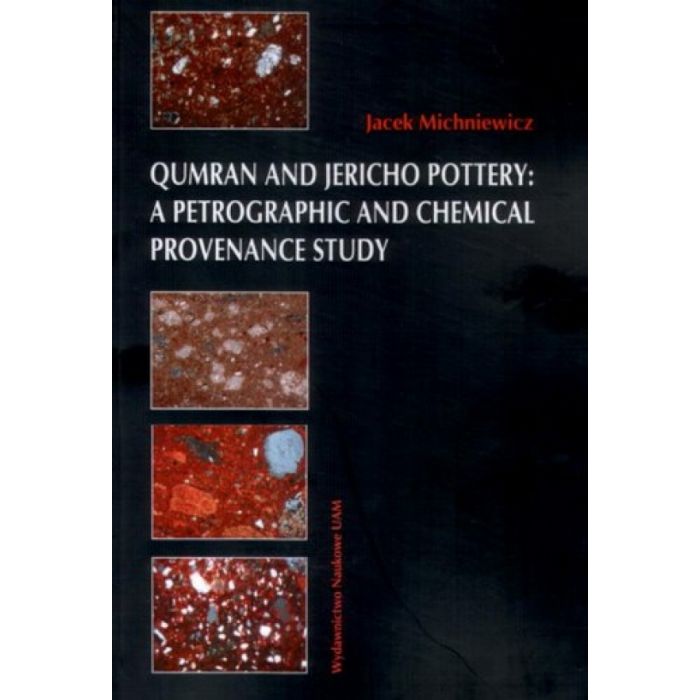Qumran and Jericho pottery: a petrographic and chemical provenance study
- In Stock: in stock
- ISBN: 978-83-232-2002-2
- Category: OUTLET, Geography/Geology
- Year of publication: 2009
Książka zawiera monograficzne opracowanie petrograficzno-geochemiczne starożytnej ceramiki pochodzącej ze stanowisk Qumran i Jerycho w basenie Morza Martwego. Jest to interesujące studium z dziedziny interdyscyplinarnej nauki zwanej archeometrią lub petroarcheologią, poświęcone ważnym i powszechnie znanym na całym świecie stanowiskom archeologicznym. Autora cechuje nowoczesne podejście do podejmowanego tematu badawczego, rzetelny warsztat metodyczny, staranne opracowanie, wnikliwa interpretacja i dyskusja wyników.
This book is a petrographic and chemical study of ancient pottery coming from the Dead Sea region. It is a study in the field of an interdisciplinary science called archaeometry and is devoted to the important and worldwide known archaeological sites: Qumran, Jericho and smaller on the coast of Dead Sea like Khirbet Mazin and Callirrhoe ('Ain ez-Zara). Pottery from these sites as well as clay samples collected in the field are compared with one another with respect to chemical, mineral and micropaleontological composition, which is documeted by numerous colour photographs, charts and tables. On the level of interpretations the author polemicises with a thesis recently forced by Israeli archeologists that during the first century C.E. the Qumran site was a pottery production center whose raw material came in by water supply system.
Acknowledgements
- 1. INTRODUCTION
1.1. Location of Qumran in the light of the geological structure of the region- 1.2. What knowledge can be gained from petrographic and chemical investigations, and what are their limitations?
- 1.3. Prior investigations
- 1.4. Analytical methods
- 1.5. Search for potential clay deposits and laboratory tests of the clay samples collected in the field
- 1.5.1. Hebron
- 1.5.2. En Gedi
- 1.5.3. Wadi Qumran
- 1.6. Experimental clay firing
2. OIL LAMPS FROM THE QUMRAN SITE AND THE JERICHO WINTER PALACES
- 2.1. Object of study
- 2.2. Results of petrographic examination
- 2.2.1. PETROGRAPHIC GROUP I (Foraminiferous Clay Group)
- 2.2.2. PETROGRAPHIC GROUP II (Rich Clay - Calcareous Sand Group)
- 2.2.3. PETROGRAPHIC GROUP III (Rich Clay - Quartz Sand Group)
- 2.2.4. LAMPS NOT ASSIGNED TO ANY OF THE GROUPS
- 2.3. Chemical data and mathematical interpretation
- 2.3.1. Principal components analysis
- 2.3.2. Spanning tree
- 2.4. Comparison of the results of geochemical analyses with those of petrographic observations
- 2.5. Summing up
3. JERICHO - COMMON CERAMICS FROM HASMONEAN AND HERODIAN PALACES
- 3.1. Object of study
- 3.2. Petrography
- 3.2.1. PETROGRAPHIC GROUP I (Foraminiferous Clay Group)
- 3.2.2. PETROGRAPHIC GROUP II (Rich Clay - Calcareous Sand Group)
- 3.2.3. PETROGRAPHIC GROUP III (Rich Clay - Quartz Sand Group)
- 3.2.4. PETROGRAPHIC GROUP IV (Terra Rossa Group)
- 3.3. Results of chemical analyses and their mathematical interpretation
- 3.3.1. Principal components analysis
- 3.4. Summing up
4. QUMRAN COMMON WARES AND COMPARISON WITH THE JERICHO POTTERY
- 4.1. Object of study
- 4.2. Results of petrographic examinations
- 4.2.1. PETROGRAPHIC GROUP I (Foraminiferous Clay Group)
- 4.2.2. PETROGRAPHIC GROUP II (Rich Clay - Calcareous Sand Group)
- 4.2.3. PETROGRAPHIC GROUP III (Rich Clay - Quartz Sand Group)
- 4.2.4. PETROGRAPHIC GROUP IV (Terra Rossa Group)
- 4.2.5. The remaining specimen no. 90
- 4.3. Results of chemical analyses
- 4.4. Chemical similarities and differences between the Qumran and Jericho ceramics
- 4.5. Genesis of the chemical variability of the Qumran and Jericho ceramics
- 4.6. Summing up
5. CERAMICS FROM QUMRAN AND JERICHO AS COMPARED WITH EZ-ZARA AND KHIRBET MAZIN POTTERY AND CLAYS SAMPLED IN THE FIELD
- 5.1. Petrographic investigations
- 5.2. Comparative chemical analysis
- 5.3. Interpretation of the results
- 5.4. Are the Qumran ceramics made of Wadi Qumran deposits?
- 5.5. Conclusions
References
List of figures
List of tables
Ceramika z Qumran i Jerycho. Petrograficzno-chemiczne badania nad jej pochodzeniem (Streszczenie)
| Detailed information | |
|---|---|
| Publication Version | printed |
| Format | 17,0 x 24,0 |
| Type of publication | Monografia |
| Edition | I |
| ISBN | 978-83-232-2002-2 |
| Number of pages | 169 |
| Type of binding | paperback |
